Mars 2020

UTC
I left my telescope out all night after imaging Venus with the hopes of imaging Mars. To my surprise, everything was covered in slushy dew when I came back. The sky was also full of thin clouds.
Viewing the red channel by itself helps brings out surface features, while the blue channel brings out the ice clouds.
Notes:
- There appears to be an ice cloud near the terminator, the line between day and night.
- I suspect the South Polar Hood is visible in the blue channel
- Mare Sirenum is visible as a dark area straddling the southern limb of Mars.
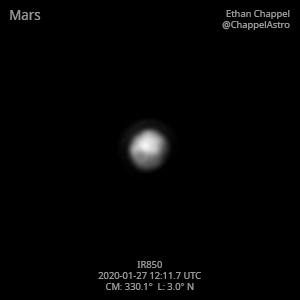
UTC
Started the day with the scariest event I've ever experienced: waking up to an alarm. I had the phone set to full volume and laying next to my ear. My heart was still racing at the end of the imaging session, making it slightly difficult to precisely focus the telescope.
Notes:
- Syrtis Major is setting.
- Sinus Sabeaus is at the central meridian.

UTC
Started the day with the scariest event I've ever experienced: waking up to an alarm. I had the phone set to full volume and laying next to my ear. My heart was still racing at the end of the imaging session, making it slightly difficult to precisely focus the telescope.
Notes:
- Syrtis Major is setting.
- Sinus Sabeaus is at the central meridian.

UTC
Started the day with the scariest event I've ever experienced: waking up to an alarm. I had the phone set to full volume and laying next to my ear. My heart was still racing at the end of the imaging session, making it slightly difficult to precisely focus the telescope.
Notes:
- Syrtis Major, which is setting, has a water-ice cloud over it.
- Sinus Sabeaus is at the central meridian.

UTC
Stepping outside and feeling the cold air, I immediately saw a meteor heading south between Mars and Antares. I had decent seeing and excellent transparency while imaging the red planet.
Notes:
- Orographic clouds are covering Olympus Mons and Pavonis Mons.
- The South Polar Cap is emerging from winter. It will shrink significantly as Mars approaches opposition.
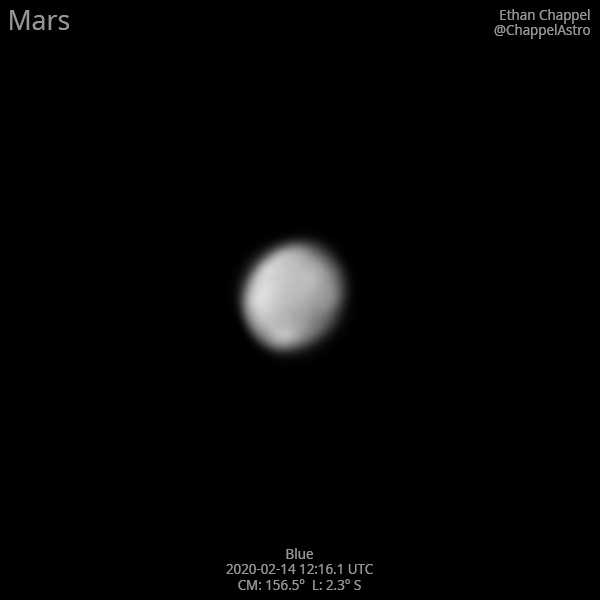
UTC
Stepping outside and feeling the cold air, I immediately saw a meteor heading south between Mars and Antares. I had decent seeing and excellent transparency while imaging the red planet.
Notes:
- Orographic clouds are covering Olympus Mons and Pavonis Mons.
- The South Polar Cap is emerging from winter. It will shrink significantly as Mars approaches opposition.
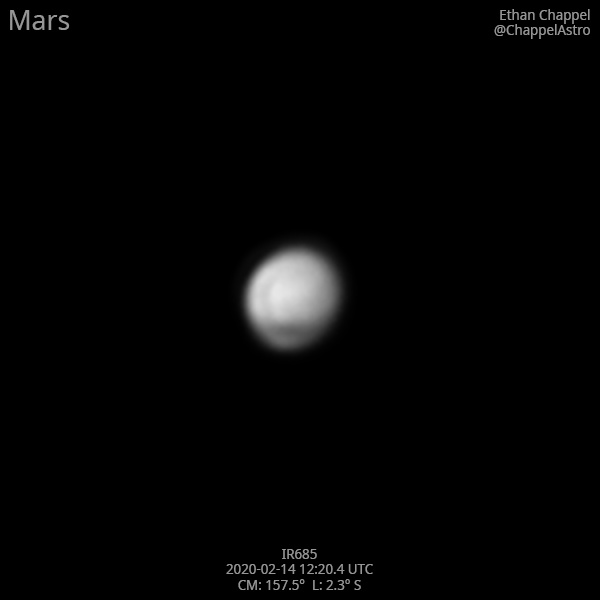
UTC
Stepping outside and feeling the cold air, I immediately saw a meteor heading south between Mars and Antares. I had decent seeing and excellent transparency while imaging the red planet.
Notes:
- The South Polar Cap is emerging from winter. It will shrink significantly as Mars approaches opposition.

UTC
Moved on to Mars from Saturn as the sky began to brighten. Seeing was still turbulent thanks to the jet stream.
Notes:
- Hellas Basin and Syrtis Major are at the central meridian.
- Sinus Meridiani is rising.

UTC
Moved on to Mars after starting the morning with Saturn. Continued to experience poor conditions.
Notes:
- Hellas Basin and Syrtis Major are approaching the central meridian.

UTC
Third consecutive morning of imaging Mars. Although the air temperature was similar during all three imaging sessions, it was nice not to endure a chilly breeze while capturing this image.
Notes:
- Hellas Basin and Syrtis Major are approaching the central meridian.

UTC
Seeing was tough for Jupiter & Saturn, but it took a turn for the worse by the time I reached Mars. I only used the best 5% of frames, the lowest for any set of images since I started planetary imaging over six years ago.
Notes:
- Hellas Basin, which appears to be obscured by a bright dust cloud, is rotating into view.
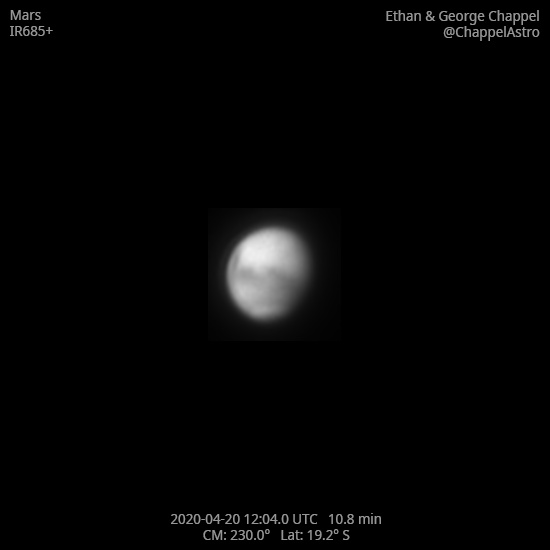
UTC
Seeing was tough for Jupiter & Saturn, but it took a turn for the worse by the time I reached Mars. I only used the best 5% of frames, the lowest for any set of images since I started planetary imaging over six years ago.
Notes:
- Hellas Basin, which appears to be obscured by a bright dust cloud, is rotating into view alongside Syrtis Major to the north.

UTC
Seeing and transparency were pretty good this morning. Unfortunately, I missed out on using the C14 because I anticipated strong wind.
Notes:
- The South Polar Cap is large. It will shrink over the next few months.

UTC
Seeing and transparency were pretty good this morning. Unfortunately, I missed out on using the C14 because I anticipated strong wind.
Notes:
- The South Polar Cap is large. It will shrink over the next few months.

UTC
Excellent transparency as usual, but poor seeing conditions strike again.
Notes:
- The South Polar Cap is large. It will shrink over the next few months.

UTC
Excellent transparency as usual, but poor seeing conditions strike again.
Notes:
- The South Polar Cap is large. It will shrink over the next few months.

UTC
This morning saw improvements in imaging conditions compared to previous mornings.
Notes:
- Tharsis is covered by orographic clouds on the terminator.
- To the north of Tharsis, Olympus Mons is rotating off the sunlit side.

UTC
This morning saw improvements in imaging conditions compared to previous mornings.
Notes:
- The Tharsis volcanoes and Olympus Mons are rotating off the sunlit side.

UTC
A new month has brought improved seeing conditions. The air was very humid, requiring strong dew control to keep the C14 dew-free.
Notes:
- Valles Marineris, covered by orographic clouds, is rotating off the day side.

UTC
A new month has brought improved seeing conditions. The air was very humid, requiring strong dew control to keep the C14 dew-free.
Notes:
- Valles Marineris is rotating off the day side.

UTC
Nearly perfect conditions for imaging Mars this morning.
Notes:
- The North Polar Hood, a seasonal formation of clouds that appears during Martian autumn and winter, is peeking over the limb.
- Valles Marineris is front and center.
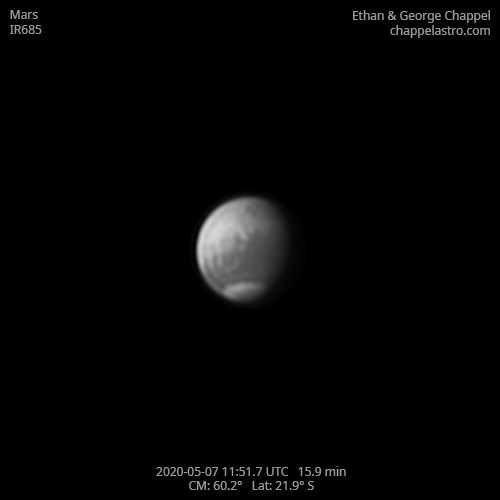
UTC
Nearly perfect conditions for imaging Mars this morning.
Notes:
- Valles Marineris is front and center.

UTC
Seeing was very good during my time with Mars this morning.
Notes:
- Syrtis Major and Hellas Basin are setting.
- Based on the orange tint over the South Pole, a small dust storm may be be occurring there.

UTC
Seeing was very good during my time with Mars this morning.
Notes:
- Syrtis Major and Hellas Basin is setting.

UTC
After having good conditions for Jupiter and Saturn, seeing became worse by the time I got to Mars.
Notes:
- Syrtis Major and Hellas Basin are about to rotate off the day side.
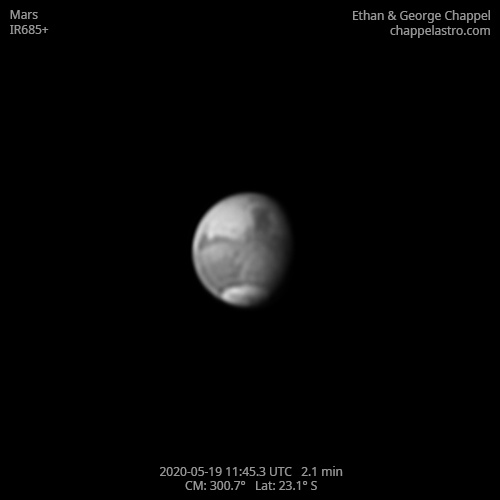
UTC
After having good conditions for Jupiter and Saturn, seeing became worse by the time I got to Mars.
Notes:
- Syrtis Major and Hellas Basin are about to rotate off the day side.

UTC
The sky was brightening quickly, so I had to move on to Mars after a short time with Neptune. Seeing was excellent and transparency was good.
Notes:
- Orographic clouds are visible near the Tharsis volcanoes.
- Valles Marineris is rotating of the day side.
- Terra Sirenum is at the central meridian.

UTC
The sky was brightening quickly, so I had to move on to Mars after a short time with Neptune. Seeing was excellent and transparency was good.
Notes:
- Valles Marineris is rotating of the day side.
- Terra Sirenum is at the central meridian.

UTC
Very good conditions for imaging. Mars is starting to get noticeably higher in the Sky than Jupiter and Saturn even though it still doesn't reach the meridian by sunrise.
Notes:
- Orographic clouds are visible near the Tharsis volcanoes.
- Valles Marineris is rotating of the day side.
- Terra Sirenum is approaching the central meridian.

UTC
Very good conditions for imaging. Mars is starting to get noticeably higher in the Sky than Jupiter and Saturn even though it still doesn't reach the meridian by sunrise.
Notes:
- Valles Marineris is rotating of the day side.
- Terra Sirenum is approaching the central meridian.

UTC
Seeing conditions improved enough to make capturing a high resolution image of Mars easier than it was for Jupiter and Saturn.
Notes:
- Orographic clouds are visible near the Tharsis volcanoes.
- Valles Marineris is rotating of the day side.
- Terra Sirenum is rising.
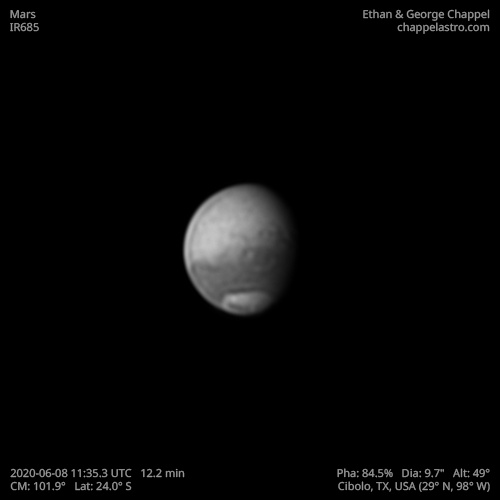
UTC
Seeing conditions improved enough to make capturing a high resolution image of Mars easier than it was for Jupiter and Saturn.
Notes:
- Orographic clouds are visible near the Tharsis volcanoes.
- Valles Marineris is rotating of the day side.
- Terra Sirenum is rising.

UTC
Less than good seeing but excellent transparency during this imaging session.
Notes:
- Valles Marineris is at the central meridian.

UTC
Less than good seeing but excellent transparency during this imaging session.
Notes:
- Valles Marineris is at the central meridian

UTC
Seeing improved greatly after having a tough time with Jupiter and Saturn.
Notes:
- Valles Marineris is at the central meridian.

UTC
Seeing improved greatly after having a tough time with Jupiter and Saturn.
Notes:
- Valles Marineris is at the central meridian

UTC
Seeing improved greatly once I moved on to Mars from Jupiter and Saturn.
Notes:
- Valles Marineris is at the central meridian.
- Solis Lacus is approaching the central meridian.

UTC
Seeing improved greatly once I moved on to Mars from Jupiter and Saturn.
Notes:
- Valles Marineris is at the central meridian.
- Solis Lacus is approaching the central meridian.

UTC
Very good seeing arrived after some decent conditions with Jupiter and Saturn. Mars is starting to climb higher in the sky as it moves north in the sky.
Notes:
- Chryse and Niliacus Lacus are on the central meridian.
- Valles Marineris is approaching the central meridian.
- Solis Lacus is rising.
- Sinus Meridiani is setting.

UTC
Very good seeing arrived after some decent conditions with Jupiter and Saturn. Mars is starting to climb higher in the sky as it moves north in the sky.
Notes:
- Chryse and Niliacus Lacus are on the central meridian.
- Valles Marineris is approaching the central meridian.
- Solis Lacus is rising.
- Sinus Meridiani is setting.

UTC
Excellent morning of seeing and transparency.
Notes:
- A feature that appears similar to a high altitude plume is extending from the terminator near the South Polar Cap.
- Chryse and Niliacus Lacus are on the central meridian.
- Valles Marineris and Solis Lacus are rising.
- Sinus Meridiani and Sabaeus are setting.

UTC
Excellent morning of seeing and transparency.
Notes:
- A feature that appears similar to a high altitude plume is extending from the terminator near the South Polar Cap. This feature is more prominent in visible light
- Chryse and Niliacus Lacus are on the central meridian.
- Valles Marineris and Solis Lacus are rising.
- Sinus Meridiani and Sabaeus are setting.

UTC
Clouds were rolling in, so I had to catch Mars earlier than normal. Barely had enough time to record all color channels.
Notes:
- Syrtis Major and Hellas Basin are rising. Hellas looks like it is covered by a dust cloud.


UTC
Good seeing by the time I got to Mars. The South Polar Cap continues to shrink as the frozen carbon dioxide sublimates back into the atmosphere.

UTC
Good seeing by the time I got to Mars. The South Polar Cap continues to shrink as the frozen carbon dioxide sublimates back into the atmosphere.

UTC
After waiting out some clouds that prevented imaging Saturn and Neptune, I managed to capture Mars with some difficulty. There is a regional dust storm extending over Tyrrhenum while the rest of the planet looks hazy.

UTC
After waiting out some clouds that prevented imaging Saturn and Neptune, I managed to capture Mars with some difficulty. There is a regional dust storm extending over Tyrrhenum while the rest of the planet looks hazy.


UTC
Pretty good seeing. Olympus and Ascraeus Mons are visible as dark red spots, suggesting dust being suspended in the atmosphere.

UTC
Pretty good seeing. Olympus and Ascraeus Mons are visible as dark red spots, suggesting dust being suspended in the atmosphere.


UTC
Deteriorating conditions with clouds rolling in bad seeing.
First light with my new ASI462MC. This was used without the Atmospheric Dispersion corrector since I couldn't figure out how to make it fit in the existing imaging train.

UTC
Difficult conditions as seeing deteriorated and clouds moved in. Valles Marineris is rotating into view.

UTC
Great seeing conditions. Solis Lacus and Valles Marineris are approaching the central meridian.

UTC
Great seeing conditions. Solis Lacus and Valles Marineris are approaching the central meridian.

UTC
My first attempt at Mars was cut short by clouds rolling in. However, they moved on as dawn started, so I quickly prepped the telescope and aimed at Mars as it soared overhead in the brightening sky. Despite the occasional thin cloud, seeing was excellent. Valles Marineris is at the central meridian.

UTC
My first attempt at Mars was cut short by clouds rolling in. However, they moved on as dawn started, so I quickly prepped the telescope and aimed at Mars as it soared overhead in the brightening sky. Despite the occasional thin cloud, seeing was excellent. Valles Marineris is at the central meridian.

UTC
Excellent conditions for a second night in a row, but without the dawn sky and thin clouds. The South Polar Cap has lost its circular shape as it shrinks.

UTC
Excellent conditions for a second night in a row, but without the dawn sky and thin clouds. The South Polar Cap has lost its circular shape as it shrinks.

UTC
Excellent conditions for a second night in a row, but without the dawn sky and thin clouds. The South Polar Cap has lost its circular shape as it shrinks.








UTC
Excellent conditions. The Mountains of Mitchel are starting to separate from the South Polar Cap.

UTC
Excellent conditions. The Mountains of Mitchel are starting to separate from the South Polar Cap.





UTC
Good seeing. The Mountains of Mitchel continue to separate from the South Polar Cap.

UTC
Good seeing. The Mountains of Mitchel continue to separate from the South Polar Cap.

UTC
Good seeing. The Mountains of Mitchel continue to separate from the South Polar Cap.

UTC
Good seeing. The Mountains of Mitchel continue to separate from the South Polar Cap.

UTC
Good seeing. The Mountains of Mitchel continue to separate from the South Polar Cap.

UTC
Good seeing. The Mountains of Mitchel continue to separate from the South Polar Cap.

UTC
Seeing was a little underwhelming at the start of my time imaging Mars, but improved greatly by the end.
Syrtis Major and Hellas Basin are rising.
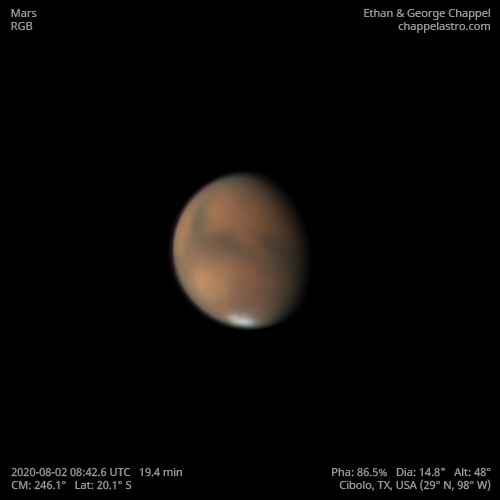
UTC
Seeing was a little underwhelming at the start of my time imaging Mars, but improved greatly by the end.
Syrtis Major and Hellas Basin are rising.

UTC
Seeing was a little underwhelming at the start of my time imaging Mars, but improved greatly by the end.
Hellas Basin appears to be covered by dust clouds.

UTC
Seeing was a little underwhelming at the start of my time imaging Mars, but improved greatly by the end.
The mountains of Mitchell have separated from the South Polar Cap.

UTC
Seeing was a little underwhelming at the start of my time imaging Mars, but improved greatly by the end.
Hellas Basin appears to be covered by dust clouds.

UTC
Seeing was a little underwhelming at the start of my time imaging Mars, but improved greatly by the end.
The mountains of Mitchell have separated from the South Polar Cap.

UTC
Seeing was a little underwhelming at the start of my time imaging Mars, but improved greatly by the end.
The mountains of Mitchell have separated from the South Polar Cap.

UTC
Seeing was a little underwhelming at the start of my time imaging Mars, but improved greatly by the end.
Sinus Meridiani and Sabaeus are rotating into view. Syrtis Major and Hellas Basin were at the central meridian.
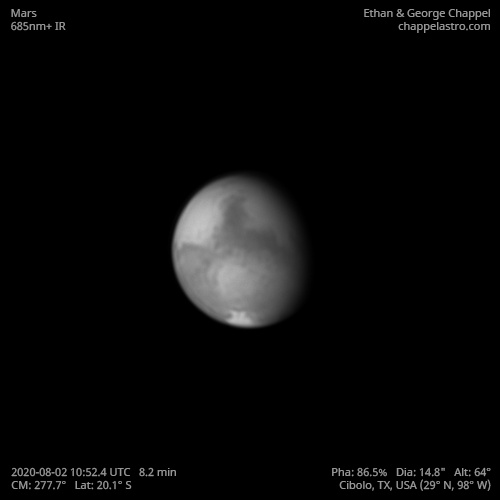
UTC
Seeing was a little underwhelming at the start of my time imaging Mars, but improved greatly by the end.
Syrtis Major and dust-covered Hellas Basin are at the central meridian.

UTC
Seeing was a little underwhelming at the start of my time imaging Mars, but improved greatly by the end.
Sinus Meridiani and Sabaeus are rotating into view.

UTC
Seeing was a little underwhelming at the start of my time imaging Mars, but improved greatly by the end.
Sinus Meridiani and Sabaeus are rotating into view. Syrtis Major and Hellas Basin were at the central meridian.

UTC
Seeing was a little underwhelming at the start of my time imaging Mars, but improved greatly by the end.
Sinus Meridiani and Sabaeus are rotating into view.






UTC
Very stable seeing conditions and good transparency. Syrtis Major and Hellas Basin are rising. The South Polar Cap is rapidly shrinking as summer approaches in the southern hemisphere.

UTC
Very stable seeing conditions and good transparency. Syrtis Major and Hellas Basin are rising. The South Polar Cap is rapidly shrinking as summer approaches in the southern hemisphere.

UTC
Very stable seeing conditions and good transparency. Syrtis Major and Hellas Basin are rising. The South Polar Cap is rapidly shrinking as summer approaches in the southern hemisphere.


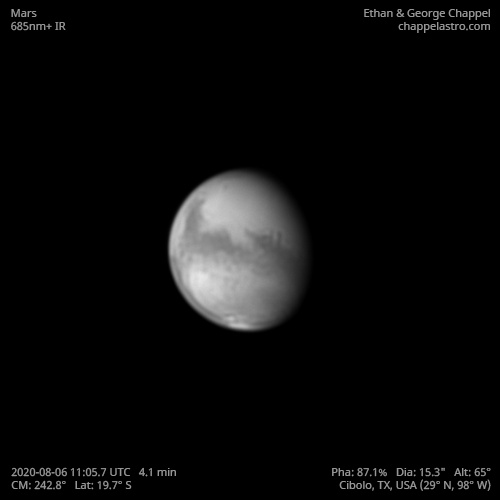



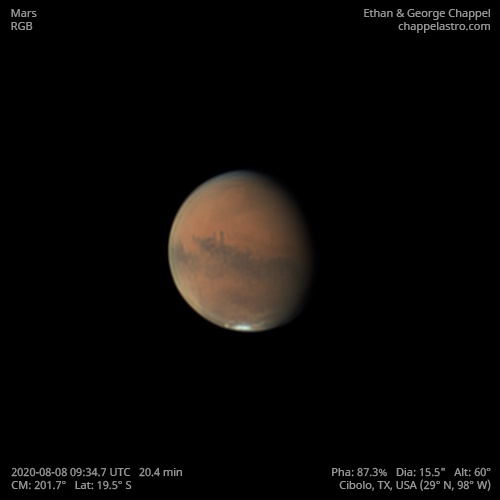
UTC
Excellent night of imaging with Mars. The increasing angular diameter is allowing more details to pop out. Mare Cimmerium is stretched across the planet's disk.

UTC
Excellent night of imaging with Mars. The increasing angular diameter is allowing more details to pop out. Mare Cimmerium is stretched across the planet's disk.






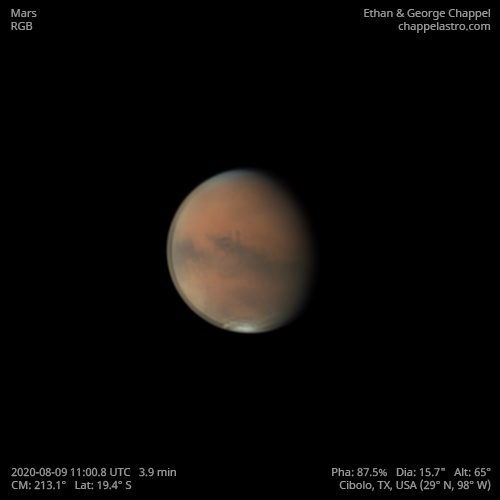










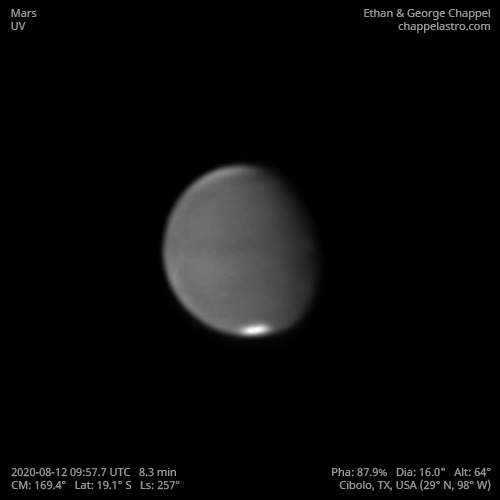












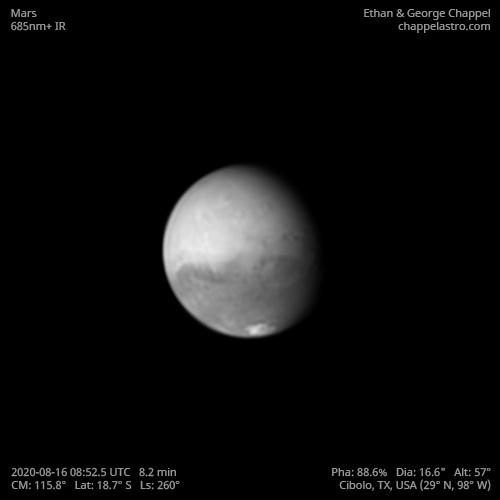


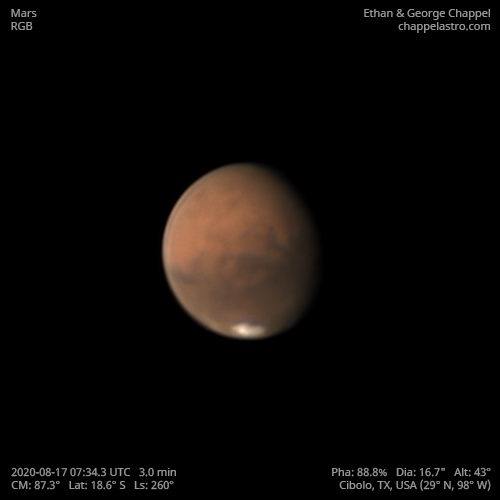










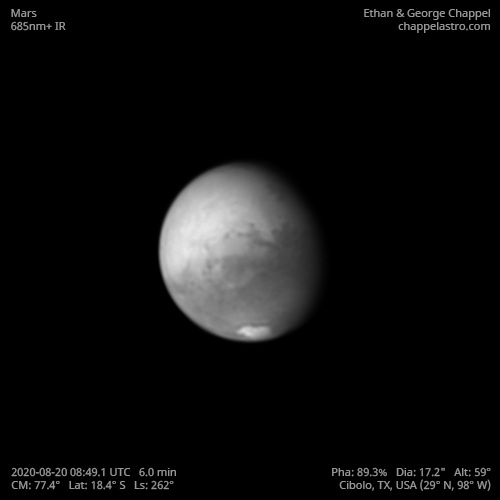



UTC
I was expecting partly cloudy skies, but it cleared for a couple hours so I took out the C8 to get a quick shot of Mars.
Notes:
- Syrtis Major and Hellas Basin is setting
- Sinus Sabaeus and Meridiani are near the central meridian.
- A band of orographic clouds has stretched around the planet in the southern hemisphere.
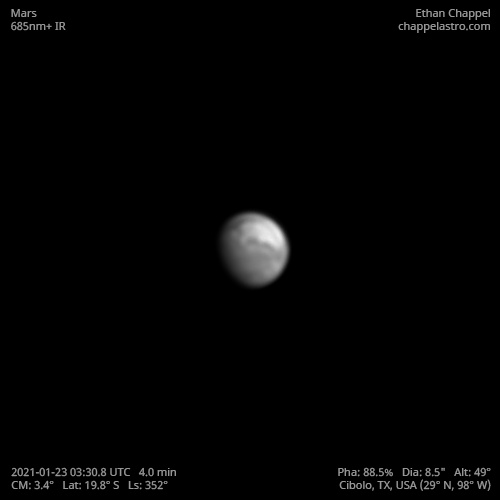
UTC
I was expecting partly cloudy skies, but it cleared for a couple hours so I took out the C8 to get a quick shot of Mars.
Notes:
- Syrtis Major and Hellas Basin is setting
- Sinus Sabaeus and Meridiani are near the central meridian.
- A band of orographic clouds has stretched around the planet in the southern hemisphere.

UTC
Imaging Mars after a tough week was a nice change of pace. Historic snow storms brought an unusually long and intense cold snap to Texas, causing much of the state to fall into rolling blackouts for days. We lost home internet access for 5 days and the cell signal became too weak for a reliable connection. Snow was brought inside to melt in case the local water supply ran dry. The air outside was a little colder than normal and small patches of snow were on the ground tonight. Seeing was good enough to get an acceptable image with enough data.
Mars passed vernal equinox two weeks ago, bringing spring to the northern hemisphere and autumn to the south. The planet is now 200 million kilometers away and just over a fourth of the angular diameter it was at opposition in October. Valles Marineris can be seen near the center of the disk.
These images were taken less than two days after Perseverance touched down on the red planet. The landing site was facing away from us when taking these images.

UTC
Imaging Mars after a tough week was a nice change of pace. Historic snow storms brought an unusually long and intense cold snap to Texas, causing much of the state to fall into rolling blackouts for days. We lost home internet access for 5 days and the cell signal became too weak for a reliable connection. Snow was brought inside to melt in case the local water supply ran dry. The air outside was a little colder than normal and small patches of snow were on the ground tonight. Seeing was good enough to get an acceptable image with enough data.
Mars passed vernal equinox two weeks ago, bringing spring to the northern hemisphere and autumn to the south. The planet is now 200 million kilometers away and just over a fourth of the angular diameter it was at opposition in October. Valles Marineris can be seen near the center of the disk.
These images were taken less than two days after Perseverance touched down on the red planet. The landing site was facing away from us when taking these images.

UTC
Pretty good seeing conditions. The weather here is starting to become nice and warm again as the beginning of spring approaches.
Syrtis Major is about to set. The Perseverance Rover landed in Jezero Crater, which is near the tip of the dark feature. Sinus Meridiani and Sabaeus are near the central meridian.

UTC
A cool night with inconsistent seeing, but waiting for a good stretch of time allowed me to get a good image.

UTC
A cool night with inconsistent seeing, but waiting for a good stretch of time allowed me to get a good image.